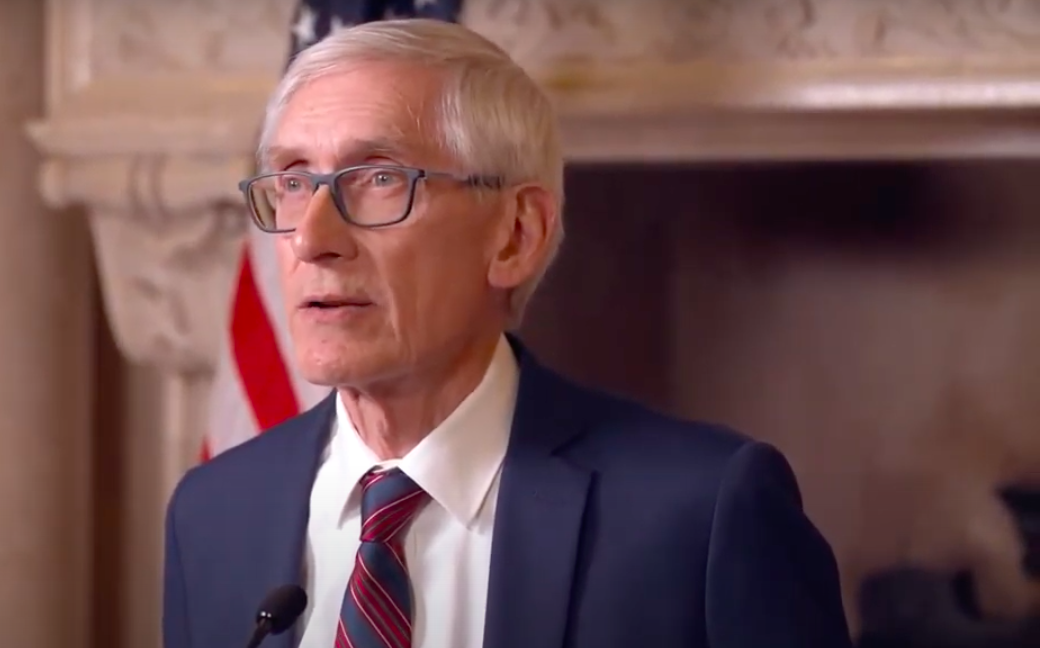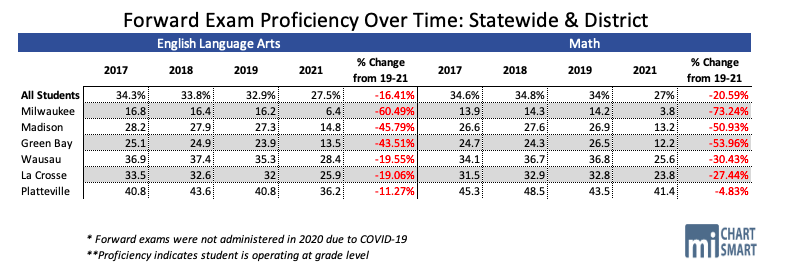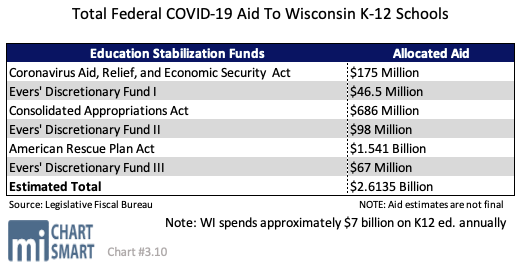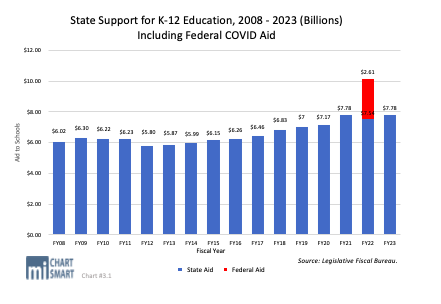
Lucky for the Governor, he fits right in with most of our K12 students
The Evers camp has put out an ad to credential him as an education expert who knows what’s best for kids. The ad makes several claims about Evers’ education record we will check against the facts.
Claim 1: Tony Evers has Taken Wisconsin Schools into the Top 10 in the U.S.
The ad repeats a brag Evers has been making for months. The top 10 ranking issued by US News, shows Wisconsin’s rank improved 10 places since the 2018 list. Evers has been taking credit for the improvement although the current ranking uses data largely from the years when Scott Walker was governor, and the lower 2018 ranking was after nearly a decade of Evers’ leadership as DPI Superintendent.
First, let’s start with the obvious. K12 student achievement numbers are trending the wrong way in Wisconsin and the most recent proficiency scores were abysmal.

Despite $2.6 billion additional federal dollars to prevent learning loss and to keep our kids on track academically, Fs increased dramatically during COVID. School funding increases every year – the most recent budget sends $2.5 billion more state aid to K12 schools than the 2015-17 budget, yet more than two-thirds of our children are not proficient in math or English language arts.


Proficient simply means that your child is able to perform at grade level. GRADE LEVEL. Not advanced or really good, but grade level.
According to the DPI website, a student who earns a basic rating on the Forward Exam “demonstrates some academic knowledge and skills tested on the statewide standardized test.” A student who earns a below basic rating on the Forward Exam “demonstrates little academic knowledge and skills tested on the statewide standardized test.”
In 2021, 53% of students who took the Forward Exam earned a basic or below basic designation in ELA and/or math. Fifty-three percent! That is fifty-three percent below grade level.
How can the Governor claim we have the 8th best education system in the nation when fifty-three percent of our students are BELOW grade level? For the Governor to deliberately ignore the real-time data and proficiency scores from actual Wisconsin children is disingenuous at best, a dirty political trick at worst.
The US News ranking Evers touts isn’t all positive – it also shows that only half of Wisconsin high school students are able to read and do math at grade level in two-thirds of Wisconsin schools.
The US News rankings Evers is taking credit for also list only one Wisconsin school where 75% of students are proficient enough to successfully complete grade level English and math coursework. Only one. Yet, somehow we rank 8th best.
The gold standard of education rankings are put out by education experts at Education Week, and show higher rankings in most of Walker’s years in office than under the Evers Administration. More problematic for Evers, the respected Education Week rankings show that when Evers was State Superintendent during the Doyle administration, there were sustained years where educational achievement in Wisconsin was ranked below 20th.
Evers is in a unique position, having held both offices, to judge whether the governor or the DPI Superintendent has more impact on schools. If he now wants us to believe it is the governor, then Evers is still playing catchup to Walker’s superior rankings.
Rating: Not Exactly.
The ranking Evers uses is not the gold standard, and the abysmal performance of our schools should have the governor working to do better for kids, not patting himself on the back for his ‘accomplishment.’
Evers cannot conveniently ignore the dismal proficiency scores while claiming the state is doing a good job educating our children.
Claim 2: Evers Is Investing in Skills and Technical Training.
The ad mentions $130 million funding for skills and technical training, likely referring to federally-funded grants the Evers administration has made. A year ago, the governor announced he would begin distributing $20 million of Wisconsin’s federal pandemic dollars for employment and skills training through the Worker Advancement Initiative. The Worker Advancement Initiative was the skills and training portion of a larger $130 million Workforce Solutions Initiative, which included things like funding for job coaches.
There is no denying that Evers sent $20 million out the door; here the question is whether it was an investment that resulted in meaningful skills and technical training.
The $20 million was distributed to local workforce development boards who were to partner with community-based organizations. The millions will be spent on just 2,300 people in the state and the funds are not required to be spent on training. Allowable uses include housing, childcare, wage subsidies, and other a variety of other services.
There are currently about 139,000 jobs listed on Job Center of Wisconsin, which by no means lists all the jobs available in the state. The 2300 people this program might provide skills or technical training would fill just 1.7% of the jobs available for a massive $20 million investment.
Also not mentioned in the ad is the fact that the funds were to be targeted at specific groups, including retirees, migrant workers and LTBTQ persons, among others.
Rating: Not Exactly.
The money was spent, but will reach few people, and the funds are not limited to providing skills and technical training as the ad suggests.
Claim 3: Evers is Investing in Mental Health Counseling for Kids
The legislature included a $19 million increase for mental health funding for schools, a provision the governor did not veto. In addition, the governor has used $15 million, again in one-time pandemic funds, to create a new mental health program in schools.
Some schools have already indicated they will use the money for “professional development” for teachers, indicating the money is not exclusively reserves for counseling for kids.
Rating: Partly true.
Evers shares credit with Republican on initiatives he signed, and the pandemic funds he allocated are not required to be spent on counseling for kids as the ad claims.
Claim 4: Evers Launched Programs to Recruit and Train Teachers
Governor Evers has provided $1 million in new grants to non-profit organizations touted as a means to relieve teacher shortages in low income and urban schools across the state.
The ad doesn’t mention that these grants were only awarded to two groups, one in Madison and one in Milwaukee.
The Milwaukee recipient, City Forward Collective, received $500,000 from DWD which they provided directly to MPS. The Madison recipient, the Urban League of Greater Madison, also received $500,000 to recruit and train 32 already-licensed teachers at a cost of over $15,000 per teacher. Presumably this recruitment of already-licensed teachers means the program drew teachers away from other Wisconsin districts and to Madison, which doesn’t relieve teacher shortages, but rather relocates the shortage.
Rating: Not Exactly.
Evers gave two non-profit groups huge grants that were supposed to be used to recruit, train and license teachers for low income or urban areas of shortage. Instead, half of the money was handed over to MPS and the other half-million dollars were used to pull 32 teachers already licensed in Wisconsin to Madison at a cost of $15,000 per teacher.
Claim 5: Evers Worked with Both Parties to Fund Schools
The ad asserts that Governor Evers ”worked with both parties to fund schools by more than we have in the last 20 years.”
K12 education is funded through the state budget and while Wisconsin’s governor introduces the biennial spending plan, the legislature has the power to completely rewrite the spending plan. During Evers’ term, sharing few priorities, the legislature made extensive use of that authority.
Evers’ budgets proposed raising the gas tax, raising taxes on farmers and manufacturers, and expanding Medicaid. On top of these initiatives, which he knew were non-starters with his legislative colleagues, Evers used his budgets to propose undoing many changes the legislature had put in place.
The strongest indicator that Evers was not serious in his desire to work across the aisle is the very education funding this ad touts. Evers’ budgets proposed increasing K12 funding $1.4 billion and $1.6 billion respectively. The $1.4 billion hike was 50% higher than any of the substantial DPI budget increases he requested from Governors Doyle and Walker during his decade as DPI Superintendent.
As DPI Superintendent, where his sole priority was K12 education, Evers’ spending wish lists were dwarfed by the massive, unrealistic proposals he made as governor, seemingly geared to partisan agitation, not collaboration.
But was Evers public posture coupled with private overtures and partnership with his legislative counterparts?
Just over 100 days into Evers’ term, after failing to agree to meet with legislative leaders himself, Evers’ staff accused GOP leaders of being sexist, and Evers backed his team, doubling down on the charge. The relationship went downhill from there, with Evers’ staff secretly recording conversations with leaders and communication between the branches largely consisting of social media sniping.
There’s no shortage of evidence that the governor and legislative leaders have not worked together well, or much at all. As governor of the state, the responsibility to try to work with all members of the legislature, including members of the other party, rests with Tony Evers.
The budgets he signed were almost wholly creations of the Republican legislature, and Evers made no bones about his displeasure in signing them, issuing dozens of vetoes. At the bill-signing for his first budget in 2019, Evers said the plan was “insufficient” because Republicans didn’t “work together and engage in constructive bipartisan dialogue.” Two years later, Evers characterized the GOP budget he signed, again with dozens of vetoes, as less than people in the state deserved.
But the ad doesn’t just claim he worked with his partisan opponents, but that he worked with both parties. Did he work with his fellow Democrats? Seemingly not much. Every Democrat voted against the first budget he signed, and only 7 voted for his second.
Rating: Not True.
Evers didn’t work with the legislature on K12 spending or policy initiatives. Evers himself criticized the two Republican budgets as he signed them, and he even threatened to veto the entire 2021-2023 budget, something that has never been done before in state history. His fellow democrats overwhelmingly opposed the Republican budgets he signed.
With 2 decades in leadership at DPI and 4 years as governor, Tony Evers should have a raft of education accomplishments to highlight in his re-election campaign. But his first education ad indicates that like the rest of us, he is struggling to determine what those accomplishments are as he brags about schools that are failing to educate our kids, touts hand-outs of one-time pandemic dollars that don’t deliver as promised, and indulges in utter fantasy about his working relationship with the legislature.